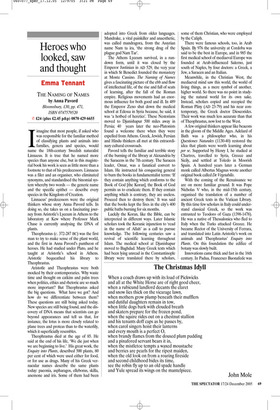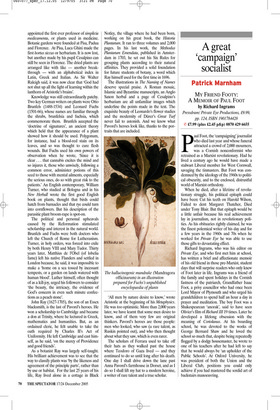Heroes who looked, saw and thought
Emma Tennant
THE NAMING OF NAMES by Anna Pavord Bloomsbury, £30, pp. 471, ISBN 0747579520 ✆ £24 (plus £2.45 p&p) 0870 429 6655 Iimagine that most people, if asked who was responsible for the familiar method of classifying plants and animals into families, genera and species, would name the 18th-century Swedish naturalist Linnaeus. It is true that he named more species than anyone else, but in this magisterial book his work is seen as little more than a footnote to that of his predecessors. Linnaeus was a filer and an organiser, who eliminated synonyms, and standardised the binomial system whereby two words — the generic name and the specific epithet — describe every species in the Kingdom of Creation.
Linnaeus’ predecessors were the original thinkers whose story Anna Pavord tells. In doing so, she takes us on a fascinating journey from Aristotle’s Lyceum in Athens to the laboratory at Kew where Professor Mark Chase is currently analysing the DNA of plants.
Theophrastus (c. 372-287 BC) was the first man to try to make sense of the plant world, and the first in Anna Pavord’s pantheon of heroes. He had studied under Plato, and he taught at Aristotle’s school in Athens. Aristotle bequeathed his library to Theophrastus.
Aristotle and Theophrastus were both mocked by their contemporaries. Why waste time and thought on catkins and palm trees when politics, ethics and rhetoric are so much more important? But Theophrastus asked the big questions. What have we got? And how do we differentiate between them? These questions are still being asked today. New species are still being found, and the discovery of DNA means that scientists can go beyond appearances and tell us that, for instance, the lotus is more closely related to plane trees and proteas than to the waterlily, which it superficially resembles.
Theophrastus died at the age of 85. He said at the end of his life, ‘We die just when we are beginning to live.’ His great work, the Enquiry into Plants, described 500 plants, 80 per cent of which were used either for food, or for use as drugs. Many of his Greek vernacular names describe the same plants today: paeonia, aspharagos, elleborus, skilla, anemone and iris. Some of them had been adopted into Greek from older languages. Mandrake, a vital painkiller and anaesthetic, was called mandragora, from the Assyrian name Nam ta ira, ‘the strong drug of the plague god Nam Tar’.
The Athens Lyceum survived, in a rundown form, until it was closed by the Emperor Justinian in AD 529, the very year in which St Benedict founded the monastery at Monte Cassino. The Naming of Names gives a fascinating picture of the ebb and flow of intellectual life, of the rise and fall of seats of learning, after the fall of the Roman empire. Religious movements had an enormous influence for both good and ill. In 489 the Emperor Zeno shut down the medical school at Edessa in Syria because, he said, it was ‘a hotbed of heretics’. These Nestorians moved to Djunishapur 500 miles away in Persia; 40 years later the neo-Platonists found a welcome there when they were expelled from Athens. Greek, Jewish, Persian and Hindu thinkers all met at this extraordinary cultural crossroads.
Pavord tells the familiar and terrible story of the burning of the library at Alexandria by the Saracens in the 7th century. The Saracen leader, Omar, was a fanatical convert to Islam. He instructed his conquering general to burn the books in fundamentalist terms: ‘If they contain anything which conforms to the Book of God [the Koran], the Book of God permits us to eradicate them. If they contain anything which is contrary, they are useless. Proceed then to destroy them.’ It was said that the books kept the fires in the city’s 400 public baths burning for six months.
Luckily the Koran, like the Bible, can be interpreted in different ways. Later Islamic scholars took the Koranic injunction to ‘read in the name of Allah’ as a call to pursue knowledge. The following centuries saw a revival of scientific learning throughout Islam. The medical school at Djunishapur moved to Baghdad. Many Greek texts which had been lying unread in the Constantinople library were translated there by scholars, some of them Christian, who were employed by the Caliph.
There were famous schools, too, in Arab Spain. By 976 the university at Cordoba was said to be the best in Europe, and in 985 the first medical school of mediaeval Europe was founded at Arab-influenced Salerno, just south of Naples, by four doctors: a Greek, a Jew, a Saracen and an Italian.
Meanwhile, in the Christian West, the mediaeval mind saw this world, the world of living things, as a mere symbol of another, higher world. So there was no point in studying the natural world for its own sake. Instead, scholars copied and recopied the Roman Pliny (AD 23-79) and his near contemporary, the Greek doctor Dioscorides. Their work was much less accurate than that of Theophrastus, now lost to the West.
A few original thinkers appear like beacons in the gloom of the Middle Ages. Adelard of Bath was a philosopher who, in his Questiones Naturales (1130-40) restored the idea that plants were worth learning about per se. Supported by Henry I, he studied at Chartres, travelled to Syria, Greece and Sicily, and settled at Toledo in Moorish Spain. A hundred years later a German monk called Albertus Magnus wrote another original book called De Vegetabilis.
With the coming of the Renaissance we are on more familiar ground. It was Pope Nicholas V who, in the mid-15th century, organised the translation of a number of ancient Greek texts in the Vatican Library. By this time few scholars in Italy could understand classical Greek, so the work was entrusted to Teodoro of Gaza (1398-1478). He was a native of Thessalonica who fled to Italy when the Turks attacked Greece. He became Rector of the University of Ferrara, and translated into Latin Aristotle’s work on animals and Theophrastus’ Enquiry into Plants. On this foundation the edifice of botany was slowly built.
Innovations came thick and fast in the 16th century. In Padua, Francesco Buonafede was appointed the first ever professor of simplicia medicamenta, or plants used in medicine. Botanic gardens were founded at Pisa, Padua and Florence. At Pisa, Luca Ghini made the first hortus siccus or herbarium. It is now lost, but another made by his pupil Cesalpino can still be seen in Florence. The dried plants are arranged like with like — another breakthrough — with an alphabetical index in Latin, Greek and Italian. As Sir Walter Raleigh said, it was now clear that ‘God had not shut up all the light of learning within the lanthorn of Aristotle’s brains’.
Knowledge was still extraordinarily patchy. Two key German writers on plants were Otto Brunfels (1488-1534) and Leonard Fuchs (1501-66), whose names are familiar through the shrubs, brunfelsia and fuchsia, which commemorate them. Brunfels accepted the ‘doctrine of signatures’, an ancient theory which held that the appearance of a plant showed how it should be used. Polygonum, for instance, had a blood-red stain on its leaves, and so was thought to cure flesh wounds. But Fuchs used his own powers of observation when he wrote, ‘Since it is clear ... that cannabis excites the mind and so injures it, those who unwisely, following a common error, administer potions of this seed to those with mental ailments, especially the serious ones, do so with great risk to the patients.’ An English contemporary, William Turner, who studied at Bologna and in his New Herball wrote the first good English book on plants, thought that birds could hatch from barnacles and that rye could turn into cornflowers. But his description of the parasitic plant broom-rape is spot-on.
The political and personal upheavals caused by the Reformation stimulated scholarship and interest in the natural world. Brunfels and Fuchs were both doctors who left the Church of Rome for Lutheranism. Turner, in holy orders, was forced into exile by both Henry VIII and Mary Tudor. Thirty years later, Matthius de l’Obel (of lobelia fame) left his native Flanders and settled in London because, he said, it was impossible to make a ‘home on a sea tossed by incessant tempests, or a garden on lands watered with human blood’. Luther himself, often thought of as a kill-joy, urged his followers to consider ‘the beauty, the intricacy, the evidence of God’s concern in even such minute confections as a peach stone’.
John Ray (1627-1705), the son of an Essex blacksmith, is the last of Pavord’s heroes. He won a scholarship to Cambridge and became a don at Trinity, where he lectured in Greek, mathematics and humanities. But, as an ordained cleric, he felt unable to take the oath required by Charles II’s Act of Uniformity. He left Cambridge and cast himself, as he said, ‘on the mercy of Providence and good friends’.
As a botanist Ray was largely self-taught. His brilliant achievement was to see that the way to classify plants was ‘by the likeness and agreement of the principle parts’, rather than by use or habitat. For the last 25 years of his life, Ray lived alone in a cottage in Black Notley, the village where he had been born, working on his great book, the Historia Plantarum. It ran to three volumes and 2,000 pages. In his last work, the Methodus Plantarum Emendata, published in Amsterdam in 1703, he set out his Six Rules for grouping plants according to their natural affinities. They provided a solid foundation for future students of botany, a word which Ray himself used for the first time in 1696.
The illustrations in The Naming of Names deserve special praise. A Roman mosaic, Islamic and Byzantine manuscripts, an Anglo Saxon herbal and a page of Cesalpino’s herbarium are all unfamiliar images which underline the points made in the text. The exquisite beauty of Leonardo’s flower studies and the modernity of Dürer’s Great Turf never fail to astonish. And we know what Pavord’s heroes look like, thanks to the portraits that are included.
‘All men by nature desire to know,’ wrote Aristotle at the beginning of his Metaphysics. He was too optimistic. More than 2,000 years later, we have learnt that some men desire to know, and of them very few are original thinkers. Pavord’s heroes are those people: men who looked, who saw (a rare talent, as Ruskin pointed out), and who then thought about what they saw, which is even rarer.
The scholars of Ferrara used to take off their hats as they walked past the house where Teodoro of Gaza lived — and they continued to do so until long after his death. One day I shall drive down the lane past Anna Pavord’s farmhouse in Dorset, and as I do so I shall lift my hat to a modern heroine, a writer of rare talent and a true scholar.



















































































 Previous page
Previous page